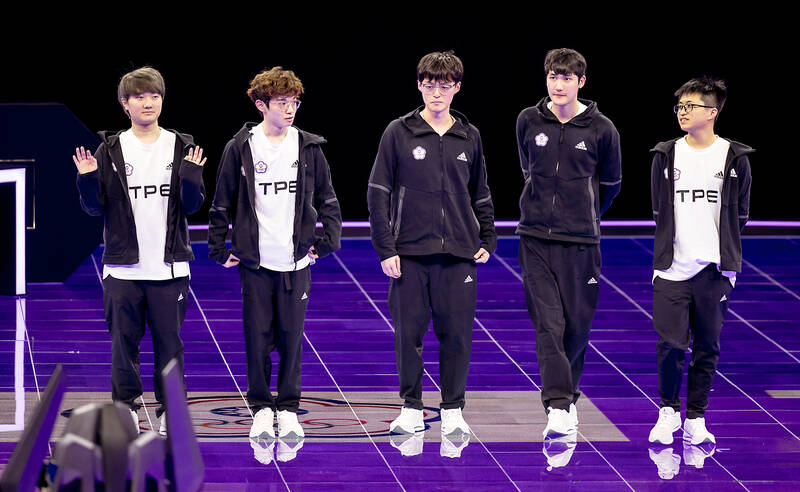Their language was salty and the message was clear: game developers believed their livelihoods were under threat and they were not going to accept it.
Unity, a US company whose software is used to create and run thousands of games including smash hits like “Pokemon GO” and “Genshin Impact,” announced on Sept. 12 new fees for developers.
The firm was going to charge 20 cents every time a Unity-backed game was installed on any device, a move that analysts warned could collapse studios and nix new releases.

Photo: EPA-EFE
Ten days later, after a spirited and often vulgarity-laden fightback from studios and developers, Unity rowed back some of the changes.
But for many developers, the damage may be irreparable.
“If I’m forced to accept the current conditions, I will leave,” said Alain Puget, director of the French studio Alkemi.

Photo: AFP
Unity claims that its technology underpins 70 percent of the top 1,000 mobile games, and that people download apps made with its software four billion times a month.
Levying even a tiny fee would reap it big rewards.
But there are plenty of alternative “engines,” as the software is known.

Photo: AFP
“Game makers have already begun to consider switching engines,” said Rhys Elliott, market analyst at the Newzoo consultancy.
‘DISCONNECTED FROM REALITY’
It was all very different back in 2005, when Unity launched with promises of democratizing game development. Its software platform was cheap and easy to use, and quickly became a favorite for independent and smaller developers.
The main innovation was that designers could build on elements from other games, such as the lighting of a background or the movements of characters.
Before Unity and its competitors emerged, each game was custom made, with graphics and everything else built from the ground up.
After a stellar rise, the firm went public in 2020.
For many industry watchers, the stock market flotation was the start of the fall.
The firm, which projects revenues of US$2 billion this year, has instituted several waves of layoffs and alienated users by tweaking the software and pricing.
Then came the Sept. 12 bombshell.
“The first proposal they made was completely disconnected from reality,” said Puget of Alkemi.
Hundreds of developers took to social media to slam a proposal they said would kill studios relying on free-to-download games and any smaller outfits that happened to develop a hit game.
“There is no way Unity talked to a single developer before launching this,” developer and consultant Rami Ismail posted on X, formerly Twitter.
The firm returned with an apology — “we heard your concerns,” “you are what makes Unity great” — and a new offer to limit the levy to the most successful games.
Puget believes the firm made a “totally unreasonable” initial proposal so that their later offer, which will still give them a huge windfall, seems more palatable.
‘STOP IT’
The vitriol from developers suggests Unity has a long way to go before it is accepted back into the fold.
Shortly after the initial announcement, an account sprang up on X to collate the responses under the handle “fucked by Unity,” gaining more than 15,000 followers in a few days.
While some developers issued heartfelt letters, others resorted to images of raised middle fingers in front of the Unity logo, or short messages with obscenities of discontent.
“Stop it. WTF?” was the stark response from Innersloth, whose game “Among Us,” made with Unity software, has an estimated 500 million players.
Puget said he was unsure if there was a way back for Unity, saying that “like everyone else” he would look at alternatives.
“It makes me sad to think that I’ve invested 13 years of learning, of research and development, in a solution that I’ll have to throw away,” he said.

In the March 9 edition of the Taipei Times a piece by Ninon Godefroy ran with the headine “The quiet, gentle rhythm of Taiwan.” It started with the line “Taiwan is a small, humble place. There is no Eiffel Tower, no pyramids — no singular attraction that draws the world’s attention.” I laughed out loud at that. This was out of no disrespect for the author or the piece, which made some interesting analogies and good points about how both Din Tai Fung’s and Taiwan Semiconductor Manufacturing Co’s (TSMC, 台積電) meticulous attention to detail and quality are not quite up to

April 21 to April 27 Hsieh Er’s (謝娥) political fortunes were rising fast after she got out of jail and joined the Chinese Nationalist Party (KMT) in December 1945. Not only did she hold key positions in various committees, she was elected the only woman on the Taipei City Council and headed to Nanjing in 1946 as the sole Taiwanese female representative to the National Constituent Assembly. With the support of first lady Soong May-ling (宋美齡), she started the Taipei Women’s Association and Taiwan Provincial Women’s Association, where she

Chinese Nationalist Party (KMT) Chairman Eric Chu (朱立倫) hatched a bold plan to charge forward and seize the initiative when he held a protest in front of the Taipei City Prosecutors’ Office. Though risky, because illegal, its success would help tackle at least six problems facing both himself and the KMT. What he did not see coming was Taipei Mayor Chiang Wan-an (將萬安) tripping him up out of the gate. In spite of Chu being the most consequential and successful KMT chairman since the early 2010s — arguably saving the party from financial ruin and restoring its electoral viability —

It is one of the more remarkable facts of Taiwan history that it was never occupied or claimed by any of the numerous kingdoms of southern China — Han or otherwise — that lay just across the water from it. None of their brilliant ministers ever discovered that Taiwan was a “core interest” of the state whose annexation was “inevitable.” As Paul Kua notes in an excellent monograph laying out how the Portuguese gave Taiwan the name “Formosa,” the first Europeans to express an interest in occupying Taiwan were the Spanish. Tonio Andrade in his seminal work, How Taiwan Became Chinese,